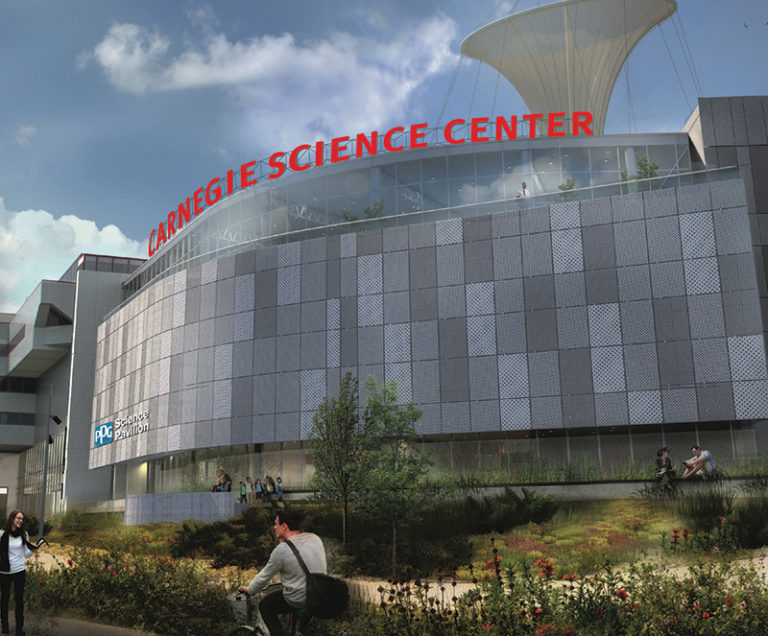Sparking a future in STEM

A rendering of the new PPG Science Pavillion by Indovina Associates Architects.
Call it a grand finale, and then some. On June 28, Carnegie Science Center announced a $7.5 million gift from PPG and the PPG Foundation to its SPARK! Campaign—the single largest donation in the history of the Science Center. The record-breaking gift, which will help fund the creation of what will be known as the PPG Science Pavilion, expands a 36-year partnership between PPG and the Science Center. It began in 1981 at the original Buhl Science Center, and continues today with PPG and PPG Foundation’s longtime support of the Science Center’s Science on the Road outreach program, which brings science to life for more than 160,000 students annually. Slated to open in June 2018, the new PPG Science Pavilion, the centerpiece of SPARK! A Campaign for Carnegie Science Center, will feature a suite of FedEx STEM Learning Labs; the Scaife Exhibit Gallery, a two-story, flexible space to host blockbuster traveling exhibits (The Art of the Brick will be the first); and PointView Hall, a new conference and event space overlooking the city’s scenic skyline.
“To meet demand—and the challenges of the changing world—we invest in resources like the PPG Science Pavilion that will excite youth about STEM fields and encourage the next generation of innovators,” says Bryan Iams, PPG vice president, corporate and
government affairs.
All told, more than 350 individuals, families, foundations, and corporations, as well as public funds, supported the successful SPARK! Campaign to the remarkable tune of $46 million. June can’t come soon enough—stay tuned!
75 Days

That’s how long 80 to 90 servicemen typically lived together each tour aboard the USS Requin (SS 481), which supported both defense and scientific missions, some of which are still classified. In May, the historic sub permanently docked at Carnegie Science Center was inducted into the Submarine Hall of Fame at the Naval Submarine Learning Center in Norfolk, Virginia. The Requin was honored as the first radar picket sub (used to increase the detection range around a force or land mass) and for her service protecting the East Coast during the Cold War.

the tree of life
“We know that there was this asteroid. But what did that asteroid impact mean for mammals in general? To me, this has been a burning question for most of my life.”
– John Wible, curator of mammals at Carnegie Museum of Natural History, told the Pittsburgh Post-Gazette about securing a $397,706 grant from the National Science Foundation to further explore the evolution of placental mammals.
Immerse yourself

dodo
This fall, experience Carnegie Museums of Art and Natural History like never before. With the goal of reaching audiences in a new and deeply personal way, Pittsburgh-based Bricolage Production Company is teaming up with Carnegie Museums as part of its Carnegie Nexus initiative. Named one of “7 Companies Producing Groundbreaking Immersive Theater” by Backstage.com, Bricolage skyrocketed onto the national stage with its first immersive production, STRATA, in 2012. After interviewing scores of museum scientists and curators, and investigating every nook and cranny of the museums’ historic Oakland facility, Bricolage is creating DODO, a sensory-based experience that blends the best of what the museums offer: art, science, human history, and behind-the-scenes surprises. Opening October 13 and running most Wednesday to Sunday evenings through November 19, participants will get a rare insider glimpse of the museums, including areas normally off limits to visitors. No two experiences will be alike. “The museums are working with Bricolage to develop an immersive production that has the potential to set a new standard for participative experiences in the theater and museum fields,” says Jo Ellen Parker, president of Carnegie Museums. “We believe the project has much to teach us, and, most importantly, great potential benefits for the audiences who will join us on this journey.” Tickets for this world-premiere immersive experience are available at nexus.carnegiemuseums.org—act fast, they’re extremely limited.
Championing inclusion

out loud app
The Andy Warhol Museum’s inclusive audio guide, The Warhol: Out Loud, took home gold at the American Alliance of Museums’ 2017 MUSE Awards for Media and Technology, which celebrates scholarship, community, innovation, creativity, education, and inclusiveness in museums. Created in partnership with Carnegie Museums’ Innovation Studio, MUSE judges said about the app: “As a shining example of universal design, The Warhol: Out Loud is a beacon in the museum technology sector and beyond.”
Chat—with a museum?

Artistic depiction of Carnegie Museums of Pittsburgh’s chatbot.
Many people consider visits to a museum a once-in-a-while thing. But what if you could interact with Carnegie Museums every day, through text messages or the camera on your smart phone? Thanks to a $150,000 grant from the John S. and James L. Knight Foundation, technologists in Carnegie Museums’ Innovation Studio are working to design and develop their own version of a popular new mobile experience: a friendly chatbot, or conversational interface, for Carnegie Museum of Art. Follow along online at studiocarnegiemuseums.org to watch “a friendly, knowledgeable, charming chatbot extension of Carnegie Museums” take shape.
Receive more stories in your email
Sign up